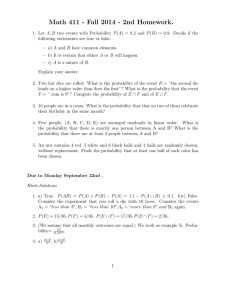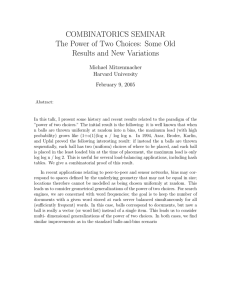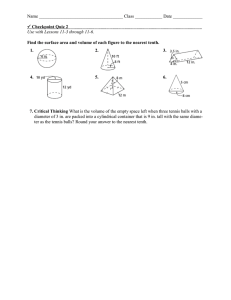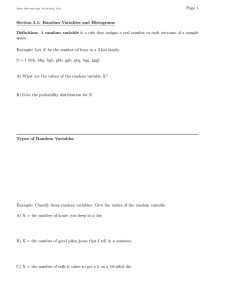INTEGERS 11 (2011) #A41 ON THE TENNIS BALL PROBLEM John M. Freeman
advertisement
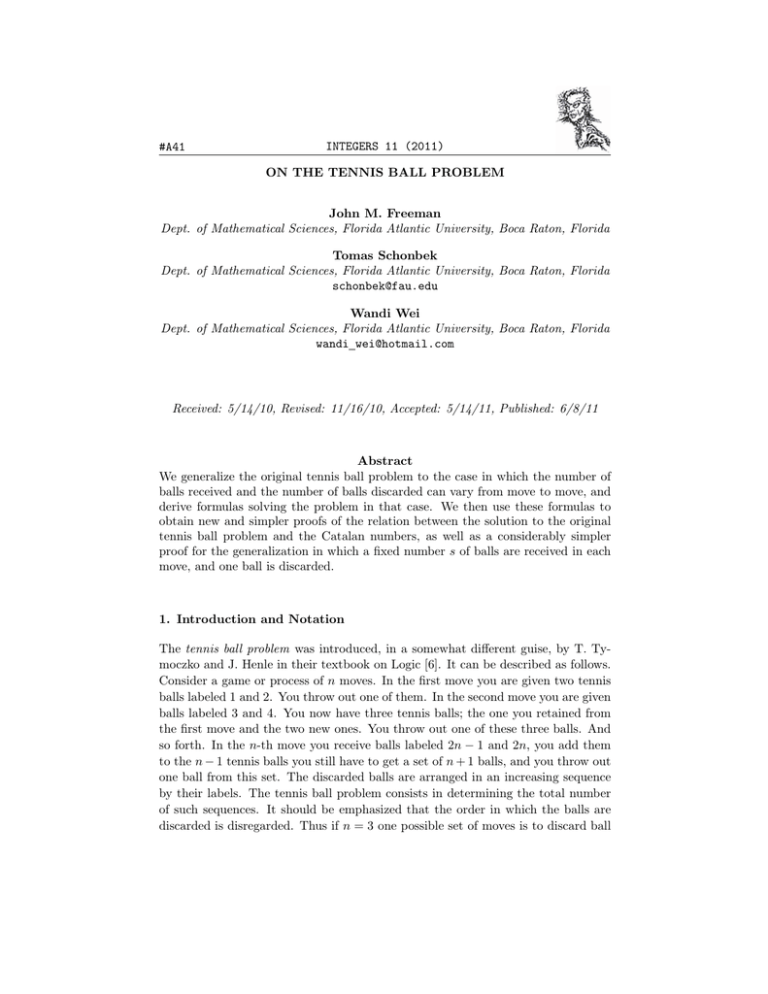
#A41
INTEGERS 11 (2011)
ON THE TENNIS BALL PROBLEM
John M. Freeman
Dept. of Mathematical Sciences, Florida Atlantic University, Boca Raton, Florida
Tomas Schonbek
Dept. of Mathematical Sciences, Florida Atlantic University, Boca Raton, Florida
schonbek@fau.edu
Wandi Wei
Dept. of Mathematical Sciences, Florida Atlantic University, Boca Raton, Florida
wandi wei@hotmail.com
Received: 5/14/10, Revised: 11/16/10, Accepted: 5/14/11, Published: 6/8/11
Abstract
We generalize the original tennis ball problem to the case in which the number of
balls received and the number of balls discarded can vary from move to move, and
derive formulas solving the problem in that case. We then use these formulas to
obtain new and simpler proofs of the relation between the solution to the original
tennis ball problem and the Catalan numbers, as well as a considerably simpler
proof for the generalization in which a fixed number s of balls are received in each
move, and one ball is discarded.
1. Introduction and Notation
The tennis ball problem was introduced, in a somewhat different guise, by T. Tymoczko and J. Henle in their textbook on Logic [6]. It can be described as follows.
Consider a game or process of n moves. In the first move you are given two tennis
balls labeled 1 and 2. You throw out one of them. In the second move you are given
balls labeled 3 and 4. You now have three tennis balls; the one you retained from
the first move and the two new ones. You throw out one of these three balls. And
so forth. In the n-th move you receive balls labeled 2n − 1 and 2n, you add them
to the n − 1 tennis balls you still have to get a set of n + 1 balls, and you throw out
one ball from this set. The discarded balls are arranged in an increasing sequence
by their labels. The tennis ball problem consists in determining the total number
of such sequences. It should be emphasized that the order in which the balls are
discarded is disregarded. Thus if n = 3 one possible set of moves is to discard ball
2
INTEGERS: 11 (2011)
1 in the first move. In the second move one gets balls 3,4; one can discard number
4. In the third move one gets balls 5,6; one can discard ball 2 (still in one’s possession). This produces the sequence (1, 2, 4). This is the same sequence produced
if we discard ball 2 in the first move, ball 1 in the second move, and ball 4 in the
third move. In [3], R.P. Grimaldi and J. Moser prove that the number
distinct
� of �
1
2n
increasing sequences after n moves equals Cn+1 , where Cn =
is the
n
n+1
n-th Catalan number.
Since the publication of the article of Grimaldi and Moser [3], a number of papers
have appeared dealing with generalizations of the problem and related problems.
Among them we want to mention the article by D. Merlini, R. Sprugnoli, and
M.C. Verri that considers the s-ball tennis problem, in which in each move s balls
are added, one is discarded (and also a particular case of the s, t problem; s balls
are added in each move and t are discarded), the article by C.L. Mallows and L.
Shapiro [4] which asks for the sum over all possible sequences in the (original) tennis
ball problem, and several as yet unpublished articles by J. Fallon, S. Gao, and H.
Niederhausen [1], [2].
In this paper we consider at first a more general form of the tennis ball problem.
We assume given positive integers s1 , . . . , sn , t1 , . . . , tn such that tj < sj for j =
1, . . . , n and consider an n-moves tennis ball game with s̄ = s1 + · · · + sn tennis
balls labeled from 1 to s̄. In the j-th move of this game, you are handed the sj
balls labeled from s1 + · · · + sj−1 + 1 to s1 + · · · + sj (with s1 + · · · sj−1 = 0 if
j = 1), and you throw out tj of the balls from among all the balls you have. As in
the original game, the labels of the discarded balls get arranged into an increasing
sequence (regardless of the order in which they were discarded). We will call such a
sequence an (s1 , . . . , sn ; t1 , . . . , tn )-set and the problem consists in determining the
total number, to be denoted by N (s1 , . . . , sn ; t1 , . . . , tn ), of (s1 , . . . , sn ; t1 , . . . , tn )sets. We find a formula for N (s1 , . . . , sn ; t1 , . . . , tn ) and then use it to produce
simplified proofs of the known results; for the s, t problem (in the terminology of [5])
if t = 1, as well as a second short proof for the original 2, 1 problem. We abbreviate
N (s1 , . . . , sn ; t1 , . . . , tn ) by N (s, t) in case s1 = · · · = sn = s, t1 = · · · = tn = t,
1 ≤ t < s.
In addition to the notation already introduced, the following notation will be used
throughout: We set t̄ = t1 + · · · + tn . Z denotes the set of integers, Z0 the set of
non-negative integers, Z+ the set of positive integers. If (k1 , . . . , kn ), (�1 , . . . , �n ) ∈
(Z0 )n , we define
(k1 , . . . , kn ) � (�1 , . . . , �n )
to mean
k1 + · · · kj ≥ �1 + · · · �j
for j = 1, . . . , n − 1; k1 + · · · kn = �1 + · · · �n .
3
INTEGERS: 11 (2011)
We will need to consider the following sets of n-tuples.
In
= {(γ1 , . . . , γn ) ∈ (Z+ )n : γj−1 + tj ≤ γj ≤ s1 + · · · + sj (1 ≤ j ≤ n)},
(where γj−1 = 0 if j = 1).
Mn
= {(m1 , . . . , mn ) : mj ≥ tj − 1, m1 + · · · + mj ≤ s1 + · · · + sj − j,
1 ≤ j ≤ n}.
= {(k1 , . . . , kn ) ∈ (Z0 )n : (k1 , . . . , kn ) � (t1 , . . . , tn )}.
�
�
1
2n
By Cn we denote the n-th Catalan number: Cn =
. We recall that
n
n+1
the Catalan numbers satisfy the recurrence relation C0 = 1, and
Kn
Cn+1 =
n
�
Cj Cn−j
(1)
j=0
for n = 0, 1, 2, . . ..
2. Results
Theorem 1. An ascending sequence
1 ≤ i1 < i2 < · · · < it̄ ≤ s̄
(2)
is an (s1 , . . . , sn ; t1 , . . . , tn )-set if and only if
(it1 , it1 +t2 , . . . , it1 +t2 +···+tn ) ∈ In
Furthermore, given an n-tuple γ = (γ1 , . . . , γn ) ∈ In , then the number of
(s1 , . . . , sn ; t1 , . . . , tn )-sets (i1 , . . . , it̄ ) with (it1 , it1 +t2 , . . . , it1 +t2 +···+tn ) = γ is given
by
�
n �
�
γj − γj−1 − 1
(γ)
N (s1 , . . . , sn ; t1 , . . . , tn ) =
(3)
tj − 1
j=1
Proof. Assume first (i1 , . . . , it̄ ) is an (s1 , . . . , sn ; t1 , . . . , tn )-set. After the j-th move,
a total of t1 + · · · + tj balls with labels in the range 1, . . . , s1 + · · · + sj have been
thrown out. The highest labeled ball, the ball now in position it1 +···+tj , must have
a label ≤ s1 + · · · + sj . As more balls get discarded in succeeding moves, this ball
can only be shifted to the right, so that the ball in position it1 +···+tj at the end of
the game has label less than or equal to the one in position it1 +···+tj after the j-th
move. It follows that it1 +···+tj ≤ s1 + · · · + sj . Moreover, since there are tj steps
between it1 +···+tj−1 and it1 +···+tj ; that is,
it1 +···+tj−1 < it1 +···+tj−1 +1 < · · · < it1 +···+tj ,
4
INTEGERS: 11 (2011)
we see that it1 +···+tj−1 +tj ≤ it1 +···+tj for j = 1, . . . , n. This proves that (it1 , . . . , itn ) ∈
In . Conversely, assume that (i1 , . . . , it̄ ) satisfies (2) and (it1 , . . . , itn ) ∈ In . One way
of playing a game that results in that sequence is as follows. Since it1 ≤ s1 , we can
throw out balls labeled from 1 to it1 in the first move, since it1 +t2 ≤ s1 + s2 , we can
throw out the balls labeled from t1 + 1 to t1 + t2 in the second move, and so forth.
It follows that (i1 , . . . , it̄ ) is an (s1 , . . . , sn ; t1 , . . . , tn )-set.
Finally, assume γ = (γ1 , . . . , γn ) ∈ In . To get an (s1 , . . . , sn ; t1 , . . . , tn )-set, for
j = 1, . . . , n with (it1 , . . . , itn ) = γ we are free to choose for the tj − 1 labels in the
range [it1 +···+tj−1 +1 , it1 +···+tj −1 ] = [γj−1 + 1, γj − 1] any strictly increasing sequence
of length tj − 1. Since there are
�
�
γj − γj−1 − 1
tj − 1
such choices, Formula (3) follows.
Our first formula for the solution to the generalized tennis ball problem follows
easily from this result.
Theorem 2. The following holds:
N (s1 , . . . , sn ; t1 , . . . , tn ) =
�
(m1 ,...,mn )∈Mn
n �
�
j=1
mj
tj − 1
�
.
Proof. It is easy to see that there is a bijection between In and Mn given by
(γ1 , . . . , γn ) �→ (m1 , . . . , mn )
where mj = γj − γj−1 − 1 for j = 1, . . . , n. If γ = (γ1 , . . . , γn ) and (m1 , . . . , mn )
are so related then Theorem 1 proves that
N
(γ)
(s1 , . . . , sn ; t1 , . . . , tn ) =
n �
�
j=1
mj
tj − 1
�
,
thus
N (s1 , . . . , sn ; t1 , . . . , tn ) =
�
N (γ) (s1 , . . . , sn ; t1 , . . . , tn )
γ∈In
=
�
n �
�
(m1 ,...,mn )∈Mn j=1
mj
tj − 1
As a corollary, we get our first proof of the formula for N (2, 1).
�
.
5
INTEGERS: 11 (2011)
Theorem 3. We have
N (2, 1) = Cn+1 =
1
n+2
�
2(n + 1)
n+1
�
.
Proof. We are assuming s1 = · · · = sn = 2, t1 = · · · = tn = 1. By Theorem 2 and
the one-to-one correspondence between Mn and In , we get
N (2, 1) = |Mn | = |In |.
Let σn = |In |, n = 1, 2, . . .. We verify directly that σ1 = 2 = C2 , σ2 = 5 = C3 .
We set σ0 = 1 = C1 . We assume from now on n ≥ 2. To count the elements of
In we can use the following strategy. A sequence (γ1 , . . . , γn ) ∈ In (in the case we
consider) if and only if 1 ≤ γ1 < γ2 < · · · < γn and γj ≤ 2j for j = 1, . . . , n. Let Inj
be the set of all sequences in In such that γj = 2j but γ� < 2� for � = 1, . . . , j − 1
(1 ≤ j ≤ n). Let us denote by Ln the set of all sequences in In that are not in Inj
for j = 1, . . . , n. If γ = (γ1 , . . . , γn ) ∈ Ln then γ1 = 1 and it is easy to see that
γ̃ = (γ2 − 1, . . . , γn − 1) ∈ In−1 . In fact, γ̃ is still strictly increasing and since the
condition of being in Ln implies that γj ≤ 2j − 1 for j = 1, . . . , n, we see that the
� − th term of γ̃ satisfies
γ̃� = γ�+1 − 1 ≤ 2(� + 1) − 2 = 2�
for � = 1, . . . , n − 1, so that the assertion follows. Conversely, given
γ = (γ̃1 , . . . , γ̃n−1 ) ∈ In−1 , one sees at once that γ = (1, γ̃1 +1, . . . , γ̃n−1 +1) ∈ Ln . It
follows that |Ln | = |In−1 | = σn−1 . Assume now 2 ≤ j ≤ n. Then, as is immediately
verified, a sequence (γ1 , . . . , γn ) ∈ Inj satisfies that (γ1 , . . . , γj−1 ) ∈ Lj−1 , (γj+1 −
2j, · · · , γn − 2j) ∈ In−j , and conversely, given a sequence (γ1 , . . . , γj−1 ) ∈ Lj−1 ,
δ = (δ1 , . . . , δn−j ) ∈ In−j , then (γ1 , . . . , γj−1 , 2j, δ1 + 2j, . . . , δn−j + 2j) ∈ Inj . Thus
|Inj | = |Lj−1 | · |In−j | = σj−2 σn−j .
If (γ1 , . . . , γn ) ∈ In1 , then γ1 = 2 and one verifies that the map (γ1 , . . . , γn ) �→
(γ2 − 2, . . . , γn − 2) is a bijection from In1 onto In−1 ; thus |In1 | = |In−1 | = σ − n − 1.
Since In is clearly the disjoint union of Ln and In1 , . . . , Inn , we get that
σn = 2σn−1 +
n
�
(4)
σj−2 σn−j .
j=2
Introducing τ0 = 1, τn = σn−1 for n = 1, 2, . . ., we can write (4) in the form
τn+1 = τ0 τn +
n
�
j=2
τj−1 τn−j+1 + τn τ0 =
n
�
τj τn−j .
j=0
This is the recursion relation (1) for the Catalan numbers; since τ0 = 1 = C0 , and
τ1 = σ0 = 1 = C1 , we conclude that τn = Cn , hence σn = Cn+1 , proving the
theorem.
6
INTEGERS: 11 (2011)
Next we get another formula for the general case.
Theorem 4. A sequence (i1 , i2 , . . . , it̄ ) satisfying (2) is an (s1 , . . . , sn ; t1 , . . . , tn )set if and only if (k1 , . . . , kn ) ∈ Kn , where
�
�
�
�
�
kj = �Z[s1 + · · · + sj−1 + 1, s1 + · · · + sj ] ∩ {i1 , i2 , . . . , it }�� ,
(5)
for j = 1, . . . , n, where Z[a, b] denotes the set of integers m such that a ≤ m ≤ b.
Proof. Suppose first that (i1 , i2 , . . . , it ) is an (s1 , . . . , sn ; t1 , . . . , tn )-set. The rules
of the game imply that t1 + · · · + tj balls are thrown out from the set labeled from 1
to s1 + · · · + sj . That means that at the end of the game the total number of balls
thrown out from the interval [1, s1 + · · · + sj ] will be at least t1 + · · · tj ; proving
k1 + · · · + kj ≥ t1 + · · · + tj for j = 1, . . . , n. However, the case n is special; all
balls have labels in the interval [1, s̄], thus k1 + · · · + kn must coincide with the
total number of balls thrown out; i.e., must equal t, completing the proof that
(k1 , . . . , kn ) ∈ Kn . Conversely assume that (i1 , i2 , . . . , it ) is an ascending sequence
and that k = (k1 , . . . , kn ) defined by (5) is in Kn . For j = 1, . . . , n, there are
k1 + · · · + kj balls in the interval [1, s1 + · · · + sj ]; since k1 + · · · + kj ≥ t1 + · · · + tj ,
the balls labeled from 1 to it1 +···+tj must be among these. It follows that there is a
game in which in the j-th round we throw out the balls labeled from it1 +···+tj−1 + 1
to it1 +···+tj ; in other words, (i1 , i2 , . . . , it ) is an (s1 , . . . , sn ; t1 , . . . , tn )-set.
Theorem 5. The following holds:
�
N (s1 , . . . , sn ; t1 , . . . , tn ) =
(k1 ,...,kn )∈Kn
�
s1
k1
�
···
�
sn
kn
�
.
Proof. This follows at once from Theorem 4
As an easy consequence, we obtain another proof of the formula for the classical
tennis ball problem, the case in which s1 = · · · = sn = 2 and t1 = · · · tn = 1.
Corollary 6. We have
1
Nn (2, 1) =
n+2
Proof. We write
σn =
�
(k1 ,...,kn )∈Kn
�
�
2
k1
2(n + 1)
n+1
�
···
�
�
2
kn
.
�
,
where now Kn consists of all n-tuples (k1 , . . . , kn ) such that (k1 , . . . , kn ) � (1, . . . , 1).
By Theorem 5, Nn (2, 1) = σn . We now follow a strategy similar to that used in the
proof of Theorem 3. Let us denote by Knj the set of all elements (k1 , . . . , kn ) ∈ Kn
7
INTEGERS: 11 (2011)
�j
such that j is the first integer ≥ 1 such that ν=1 kν = j. Clearly Kn is the disjoint
union of the sets Knj , j = 1, . . . , Knn so that
σn =
n
�
�
j
j=1 (k1 ,...,kn )∈Kn
�
2
k1
�
···
�
2
kn
�
.
Assume 2 ≤ j ≤ n and let k = (k1 , . . . , kn ) ∈ Knj . Then (kj+1 , . . . , kn ) ∈ Kn−j .
Concerning (k1 , . . . , kj ), because j ≥ 2, we must have k1 = 2. Moreover, kj = 0,
otherwise we would have had k ∈ Kni for some i < j. It is then easy to see that
(k2 , . . . , kj−1 ) ∈ Kj−2 . This defines a bijective mapping Knj → Kj−2 × Kn−j , where
we identify K0 × Kn−2 = Kn−2 = Kn−2 × K0 . The set K1 consists of all elements k
with k1 = 1; dropping that initial 1 what remains is an element of Kn−1 . It follows
that
� � �
�
�
2
2
σn =
···
+
1
kn
(k2 ,...,kn )∈Kn−1
n
�
j=2
�
(k2 , . . . , kj−1 ) ∈ Kj−2
(kj+1 , . . . , kn ) ∈ Knj
= 2σn−1 +
n
�
�
2
k2
�
···
�
2
kj−1
��
2
kj+1
�
···
�
2
kn
�
σj−2 σn−j ,
j=2
where σ0 = 1 and σ1 = 2. The numbers σn satisfy thus the relation (4) of Theorem
3, with the same initial conditions. As in that theorem, it follows that
�
�
1
2(n + 1)
σn = Cn+1 =
.
n+1
n+2
We want to generalize the result of the corollary to the case s1 = · · · = sn = s,
were s ≥ 2; t1 = · · · = tn = 1. For this we need two preparatory lemmas.
� �n+1
�n
Lemma 7. Let Xn = {(x0 , . . . , xn ) ∈ Z 0
:
j=0 xj = n} and let s ≥ 2.
Then
�
� �
� �
�
�
s
s
(n + 1)s
···
=
,
n = 0, 1, 2, . . .
x0
xn
n
(x0 ,...,xn )∈Xn
8
INTEGERS: 11 (2011)
Proof. We have
(1 + y)
(n+1)s
�
n �
s �
�
s
= (1 + y) (1 + y) · · · (1 + y) =
y xj
xj
�
��
�
x =0
s
(n+1)s
=
�
i=0
On the other hand,
(1 + y)
s
n+1
�
s
j=0
j
�
n �
�
s i
y.
xj
x0 +···+xn =i j=0
(n+1)s
=
(n+1)s �
�
i=0
(n + 1)s
i
�
yi .
The result follows equating the coefficient for y n in the two expressions for (1 +
y)(n+1)s .
�
�
s
Note. When xi > s we have
= 0.
xi
Lemma 8. Let Xn be as in Lemma 7 and let (x0 , . . . , xn ) ∈ Xn . There exists then
a unique index k such that
(xk , . . . , xk+n ) � (1, 1, . . . , 1, 0),
� �� �
(6)
n
where the indices are computed modulo n + 1.
Proof. We begin proving uniqueness. Assume two such indices exist. Without loss
of generality, we may assume that one of these indices is 1, the other one k > 1;
i.e., we may assume that
(x0 , . . . , xn ) � (1, 1, . . . , 1, 0),
(xk , . . . , xn+k ) � (1, 1, . . . , 1, 0).
(7)
(8)
In particular, by (7),
x1 + · · · + xk−1 ≥ k.
Subtracting from x0 + · · · xn = n we get
xk + · · · + xn+1 ≤ n − k,
a contradiction since, by (8), we should have xk + · · · + xn+1 ≥ n − k + 1. This
proves uniqueness.
We prove existence by induction on n. The result being obvious for n = 1,
assume it has been proved for some n ≥ 1. Let (x0 , . . . , xn+1 ) ∈ Xn+1 . There
9
INTEGERS: 11 (2011)
has to exist at least one index j with xj = 0. Since not all components can be 0,
without loss of generality we may assume that xn > 0, xn+1 = 0. Now set yj = xj
for j = 0, . . . , n − 1, yn = xn − 1. Then (y0 , . . . , yn ) ∈ Xn and by the induction
hypothesis there is k such that (yk , . . . , yn+k ) � (1, . . . , 1, 0). Let r be the index
such that k + r = 0 modulo n + 1; it is then easy to see that
(1, . . . , 1, 0) � (yk , . . . , yk+s + 1, 0, yk+s+1 , . . . , yk+n ) = (xk , . . . , xk+n+1 ).
� �� �
n+1
The lemma is proved.
We are ready to prove the promised generalization of Corollary 6.
Theorem 9. Assume s1 = s2 = · · · = sn = s ≥ 2, t1 = · · · = tn = 1. Then
�
�
1
(n + 1)s
Nn (s, 1) =
.
n
n+1
Proof. By Theorem 5,
Nn (s, 1) =
�
(x0 ,...,xn )−1∈Kn
�
s
x0
�
···
�
s
xn−1
�
.
Let x = (x0 , . . . , xn ) ∈ Xn . Suppose that there are two indices 0 ≤ l < m ≤ n such
that (xl , . . . , xl+n ) = (xm , . . . , xm+n ). Without loss of generality, we may assume
l = 0. By Lemma 8, there is an index k such that (xk , . . . , xk+n ) � (1, 1, . . . , 1, 0).
Then (xk+m , . . . , xk+m+n ) = (xk , . . . , xk+n ) � (1, 1, . . . , 1, 0), and k + m �≡ k
(mod n + 1). This contradicts the uniqueness of such an index k stated in Lemma
8. Therefore, there is an (n + 1) to one correspondence between the set Xn and
the set Kn ; if x = (x0 , . . . , xn ) ∈ Xn and if k is the unique index such that
(xk , . . . , xk+n ) � (1, 1, . . . , 1, 0), then (xk , . . . , xk+n ) ∈ Kn . We assign to x ∈ Kn
the n + 1 distinct vectors that
� can be
� obtained from x by a cyclic shift. Since we
s
must have xk+n = 0, hence
= 1, we have
xk+n
�
� �
�
�
� �
�
�
�
1
s
s
s
s
···
=
···
x0
xn−1
x0
xn
n+1
(x0 ,...,xn−1 )∈Kn
(x0 ,...,xn )∈Xn
�
�
1
(n + 1)s
=
,
n
n+1
the last equality being a consequence of Lemma 7.
Note. If s = 2 then
�
�
�
�
1
[2(n + 2)]!
1
(n + 1)s
2(n + 1)
=
=
n
n+1
n+1
(n + 1)(n + 2)!n!
n+2
so that we recover the formula of Corollary 6.
INTEGERS: 11 (2011)
10
References
[1] J. Fallon, S. Gao, H. Niederhausen, Proof of a lattice path conjecture connected to the tennis
ball problem, preprint.
[2] J. Fallon, S. Gao, H. Niederhausen, A finite operator approach to the tennis ball problem,
preprint.
[3] R.P. Grimaldi and J. Moser, The Catalan numbers and a tennis ball problem, Congressus
Numerantium 125 (1997), 65-71.
[4] C.L. Mallows and L. Shapiro, Balls on the lawn, J. Integer Sequences 2 (1999), Article 99.1.5
[5] D. Merlini, R. Sprugnoli, and M.C. Verri, The tennis ball problem, J. Combinatorial Theory,
Series A 99 (2002), 307-344.
[6] T. Tymoczko and J Henle, Sweet Reason: A Field Guide to Modern Logic, Freeman, New
York, 1995.
